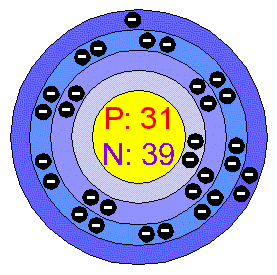|
 |
|
 |
GalliumSolid Gallium is a blue-gray metal with orthorhombic crystalline structure; very pure Gallium has a stunning silvery color. Gallium is solid at normal room temperatures, but as well as Mercury, Cesium, and Rubidium it becomes liquid when heated slightly. Solid Gallium is soft enough to be cut with a knife. It is stable in air and water; but it reacts with and dissolves in acids and alkalis. Applications Liquid Gallium wets porcelain and glass surfaces; it forms a bright,
highly reflective surface when coated on glass. It can be used to create
brilliant mirrors. Gallium easily alloys with most metals, so it is used
to form low-melting alloys. The
Plutonium pits of nuclear weapons employ an alloy with Gallium to
stabilize the allotropes of Plutonium. Gallium does not exist in pure form in nature, and Gallium compounds are not a primary source of extraction. Gallium is more abundant than lead but much less accessible bacause it has not been selectively concentrated into minerals by any geological process, so it tends to be widely dispersed. Several ores, such as the Aluminum ore bauxite, contain small amount of Gallium, and coal may have a relatively high Gallium content. Health effects of GalliumGallium is an element found in the body, but it occurs in a very small amount. For example, in a person with a mass of seventy kilograms, there are 0.7 milligrams of Gallium in the body. If this amount of Gallium was condensed into a cube, the cube would only be 0.49 millimeters long on one side. It has no proven benefit towards the function of the body, and it most likely is only present due to small traces in the natural envIronment, in water, and in residue on vegetables and fruits. Several vitamins and commercially distributed waters have been known to contain trace amounts of Gallium with less than one part per million. Pure Gallium is not a harmful substance for humans to touch. It has been handled many times only for the simple pleasure of watching it melt by the heat emitted from a human hand. However, it is known to leave a stain on hands. Even the Gallium radioactive compound, Gallium [67Ga] citrate, can be injected into the body and used for Gallium scanning without harmful effects. Although it is not harmful in small amounts, Gallium should not be purposefully consumed in large doses. Some Gallium compounds can actually be very dangerous, however. For example, acute exposure to Gallium(III) Chloride can cause throat irritation, difficulty breathing, chest pain, and its fumes can cause even very serious conditions such as pulmonary edema and partial paralysis.
|